Overview
Managing Type 2 diabetes can feel overwhelming, but you're not alone in this journey. Essential steps include:
- Lifestyle modifications such as diet and exercise
- Blood sugar monitoring
- Community support
These strategies are crucial for improving insulin sensitivity and overall health outcomes. It's understandable to feel uncertain about where to start, but remember that a comprehensive approach to diabetes management can make a significant difference.
Consider the importance of connecting with others who share similar experiences. Community support can provide encouragement and understanding, reminding you that you are not facing this alone. Additionally, potential medication may be an option to discuss with your healthcare provider, as it can further enhance your health journey.
By embracing these changes and seeking support, you can take meaningful steps toward better health. We are here to support you every step of the way, and together, we can navigate this path to wellness.
Introduction
Understanding Type 2 Diabetes is crucial in a world where nearly 38.4 million Americans are living with this condition, which accounts for a staggering 90-95% of diabetes cases. It's understandable to feel overwhelmed by this diagnosis. The journey to effective management is not just about medication; it encompasses lifestyle changes, community support, and a deep understanding of the underlying causes and risk factors.
As obesity and sedentary lifestyles become more prevalent, many individuals find themselves asking: how can they navigate the complexities of this condition and reclaim control over their health? You're not alone in this journey. This article delves into essential steps for mastering the treatment of Type 2 Diabetes, offering insights and strategies to empower you on your path to better health. We are here to support you every step of the way.
Define Type 2 Diabetes: Understanding the Condition
Condition 2 is a long-term ailment characterized by insulin resistance, where the body does not utilize insulin efficiently, leading to increased blood glucose levels. Unlike the first form, marked by the body's failure to create insulin, individuals with the second form may still generate insulin but struggle to use it effectively. This condition typically develops gradually and is linked to several risk factors, including obesity, a sedentary lifestyle, and genetic predisposition.
It's important to recognize that around 38.4 million Americans, or 11.6% of the population, are affected by this condition, with the second kind making up 90-95% of these instances. Insulin resistance significantly contributes to this prevalence, leading to serious health complications, including cardiovascular disease, which is responsible for 50% of diabetes-related deaths.
Recent research highlights a growing understanding of insulin resistance, showing that lifestyle modifications such as diet and exercise can significantly improve insulin sensitivity. For instance, studies indicate that weight reduction and enhanced physical activity can reverse insulin resistance, assisting in the control of the condition.
Real-world examples illustrate the importance of education and awareness in managing this condition. Programs that provide comprehensive diabetes education, including dietary plans and exercise routines, empower individuals to take control of their health. T2DSolutions strives to cultivate a supportive community where individuals impacted by the second type of diabetes can share personal experiences and navigate their care journey more effectively.
In summary, comprehending Type 2 Diabetes and the function of insulin resistance is essential for effective oversight and the treatment of diabetes type 2 planning. By addressing the underlying factors contributing to insulin resistance, individuals can improve their health outcomes and quality of life. Furthermore, it's crucial to acknowledge the financial consequences of this condition, which incurred $327 billion in expenses for the U.S. in 2017, comprising $237 billion in healthcare costs and $90 billion in lost productivity. T2DSolutions advocates for a comprehensive strategy in the treatment of diabetes type 2, emphasizing lifestyle modifications, mental health assistance, and community involvement, which are crucial for enhancing overall health results. Additionally, T2DSolutions tackles the emerging idea of a third form of sugar metabolism disorder, associated with Alzheimer's disease, offering valuable insights for those impacted.
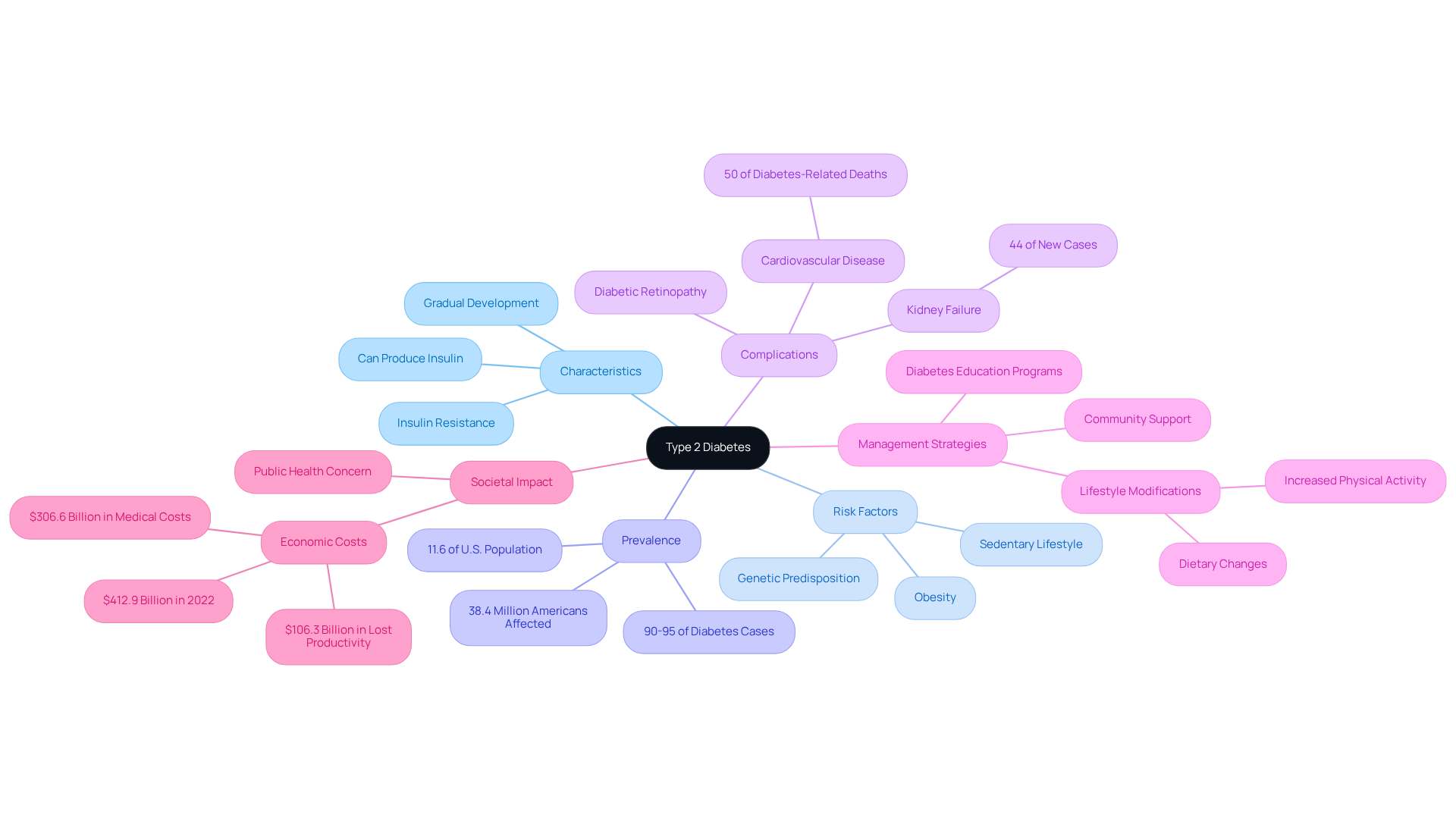
Explore Causes and Risk Factors of Type 2 Diabetes
At T2DSolutions, we understand that grasping the reasons for Type 2 Diabetes is essential for effective control. The causes are multifaceted, stemming from a blend of genetic, environmental, and lifestyle influences. Let's explore some key risk factors together:
- Obesity: Excess body fat, especially around the abdomen, significantly heightens insulin resistance. It's concerning that approximately 89.8% of adults with diagnosed high blood sugar are classified as overweight or obese. This underscores the critical link between obesity and the risk of this condition.
- Physical Inactivity: A sedentary lifestyle not only contributes to weight gain but also exacerbates insulin resistance. Alarmingly, 31.9% of adults with this condition engage in less than 10 minutes of moderate or vigorous activity weekly. This highlights a significant barrier to effective management that we can work on together.
- Age: The risk of developing Type 2 Diabetes escalates with age, particularly after 45 years. This demographic change is vital as the occurrence of diabetes-related conditions among older adults continues to rise, and it’s important to be aware of this factor.
- Family History: A hereditary tendency towards blood sugar issues can increase a person's risk. Being aware of family health history is crucial for proactive oversight, and we encourage open discussions about this.
- Ethnicity: Certain ethnic groups, including African Americans, Hispanic Americans, and Native Americans, demonstrate a greater vulnerability to this condition. This disparity emphasizes the need for targeted prevention strategies within these communities, and we are here to support those efforts.
Comprehending these risk factors enables individuals to embrace proactive health care approaches, particularly in the treatment of diabetes type 2. Participating in regular physical activity and sustaining a healthy weight can greatly lower the likelihood of needing treatment of diabetes type 2. Remember, you're not alone in this journey. At T2DSolutions, we are dedicated to offering resources and assistance for the treatment of diabetes type 2 to help you manage your condition effectively. We are here to support you every step of the way.
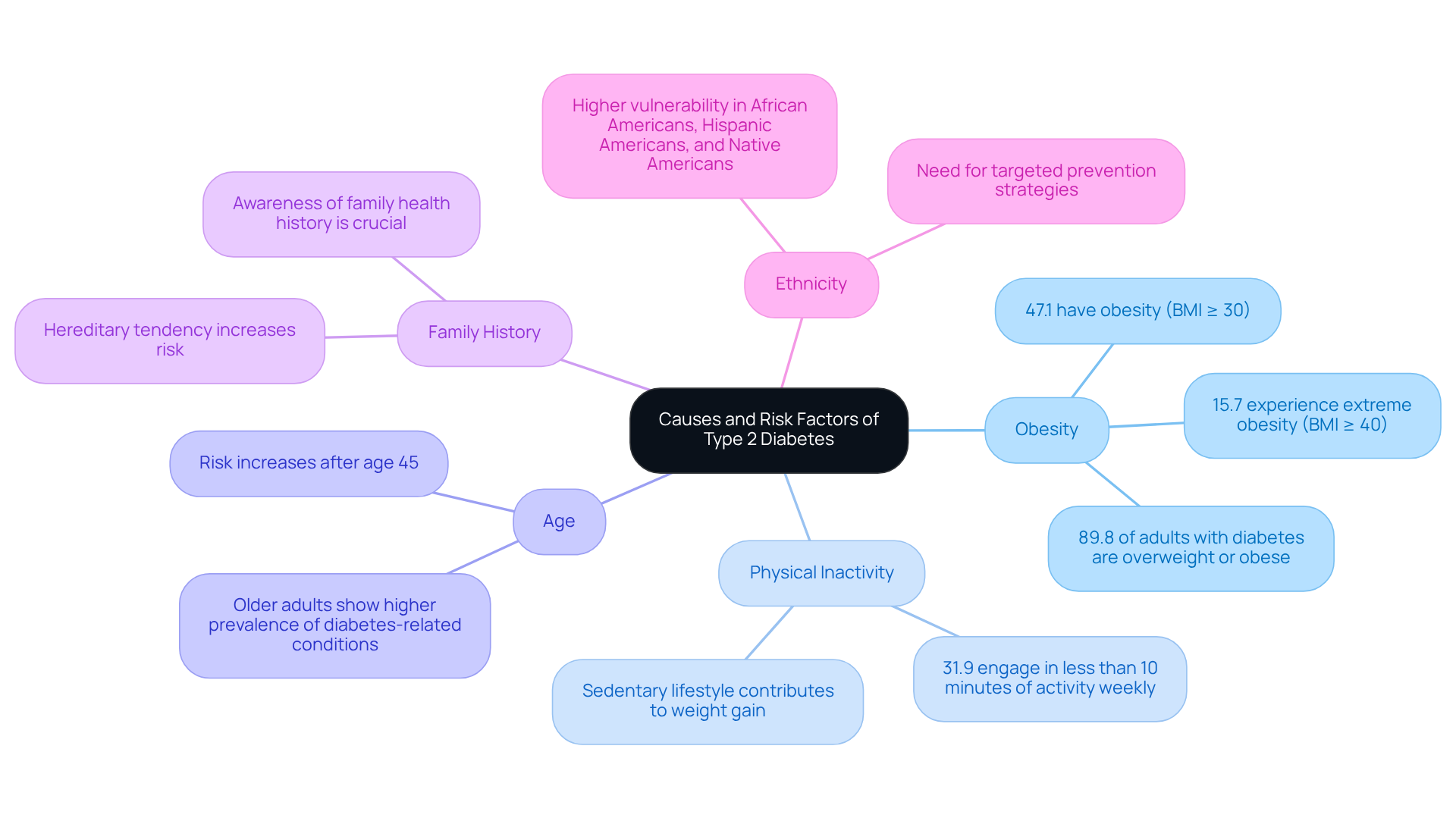
Review Treatment Options: Lifestyle Changes and Medications
Effectively managing the treatment of diabetes type 2 requires a multifaceted approach that combines lifestyle changes with medication when necessary. At T2DSolutions, we are dedicated to offering extensive resources and assistance for individuals navigating their condition.
-
Lifestyle Changes:
- Diet: A balanced diet is crucial for diabetes management. Emphasizing whole grains, fruits, vegetables, and lean proteins while minimizing processed foods and sugars can lead to significant improvements in blood sugar control. It's understandable to feel overwhelmed by dietary choices, but studies show that people who follow a diet low in red and processed meats and rich in plant-based foods have a reduced risk of developing the second type of blood sugar disorder.
- Exercise: Regular physical activity is essential, with a target of at least 150 minutes of moderate exercise each week. Engaging in consistent exercise not only aids in weight management but also enhances insulin sensitivity, reducing the risk of diabetes progression. Research indicates that physical exercise can reduce the likelihood of the second form of diabetes by roughly 50%. Remember, every step counts, and it's okay to start small.
- Weight Management: Achieving and maintaining a healthy weight is vital. Evidence indicates that losing merely 5% of body weight can lower the risk of developing a second form of diabetes by 58%. For high-risk individuals, a lifestyle intervention program that encourages weight loss has shown a 69% decrease in the occurrence of the disease after one year. You're not alone in this journey, and small changes can lead to significant results.
-
Medications: When lifestyle modifications alone are insufficient, healthcare providers may prescribe medications. Common options include Metformin, GLP-1 receptor agonists, and SGLT2 inhibitors. Metformin is often the first-line treatment, effectively lowering blood sugar levels and improving insulin sensitivity. GLP-1 receptor agonists not only help control blood sugar but also promote weight loss, while SGLT2 inhibitors provide cardiovascular benefits alongside glycemic control.
Practical illustrations emphasize the effectiveness of these medications; for instance, participants in lifestyle change programs have demonstrated a 58% lower occurrence of the second form of diabetes after attaining a modest weight reduction. Recent guidelines stress the significance of combining lifestyle modifications with pharmacotherapy to enhance the treatment of diabetes type 2 results.
In summary, a comprehensive strategy that includes dietary adjustments, regular exercise, weight management, and suitable medication can significantly enhance the treatment of diabetes type 2, leading to improved health outcomes and quality of life. T2DSolutions is here to support you every step of the way.
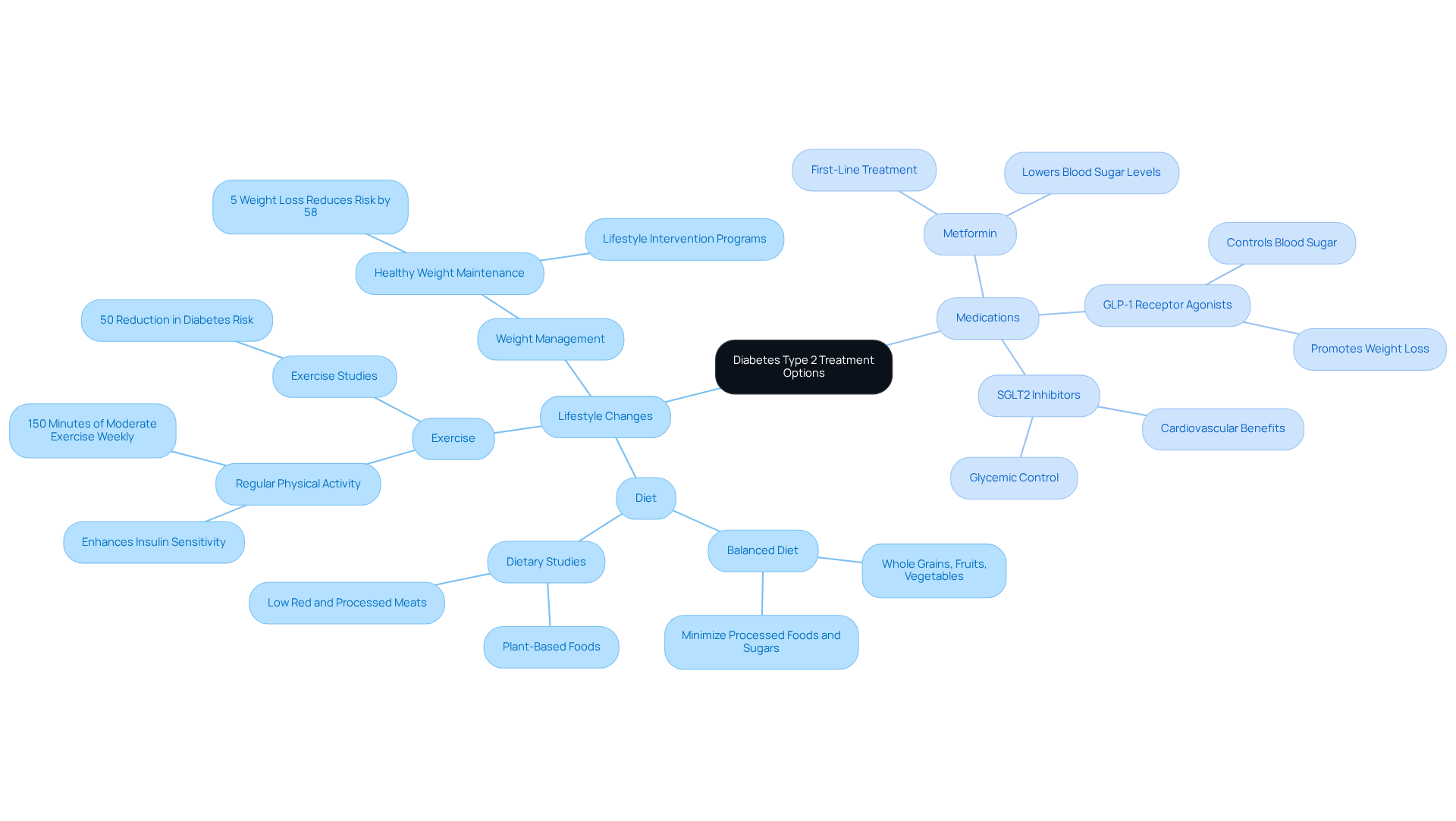
Implement Blood Sugar Monitoring and Management Strategies
Effective blood sugar monitoring is essential for the treatment of diabetes type 2 management. It involves regular testing and a clear understanding of your results, which can feel overwhelming at times, but you are not alone in this journey.
-
Methods of Monitoring:
- Self-Monitoring: Consider utilizing a glucose meter or a continuous glucose monitor (CGM) to check your blood sugar levels multiple times daily. Many patients find that CGM devices significantly improve their glycemic control, allowing them to spend about 74% of their time within the target blood sugar range of 70-180 mg/dL, which surpasses the American Diabetes Association's recommended goal of 70%.
- Understanding Targets: It's important to aim for pre-meal blood sugar levels between 80-130 mg/dL and post-meal levels below 180 mg/dL. These targets are crucial for preventing complications and maintaining your overall health.
-
Management Strategies:
- Adjusting Diet and Exercise: Use your blood sugar readings to inform your dietary choices and physical activity levels. For instance, incorporating complex carbohydrates and fiber can be a helpful way to stabilize your blood sugar levels.
- Medication Adjustments: Collaborate closely with your healthcare providers to modify medications based on your blood sugar patterns. Consistent oversight allows for prompt adjustments, ensuring optimal control of your condition.
By implementing these strategies, you can effectively manage your blood sugar levels as part of the treatment of diabetes type 2, reducing the risk of complications and enhancing your quality of life. Remember, we are here to support you every step of the way.
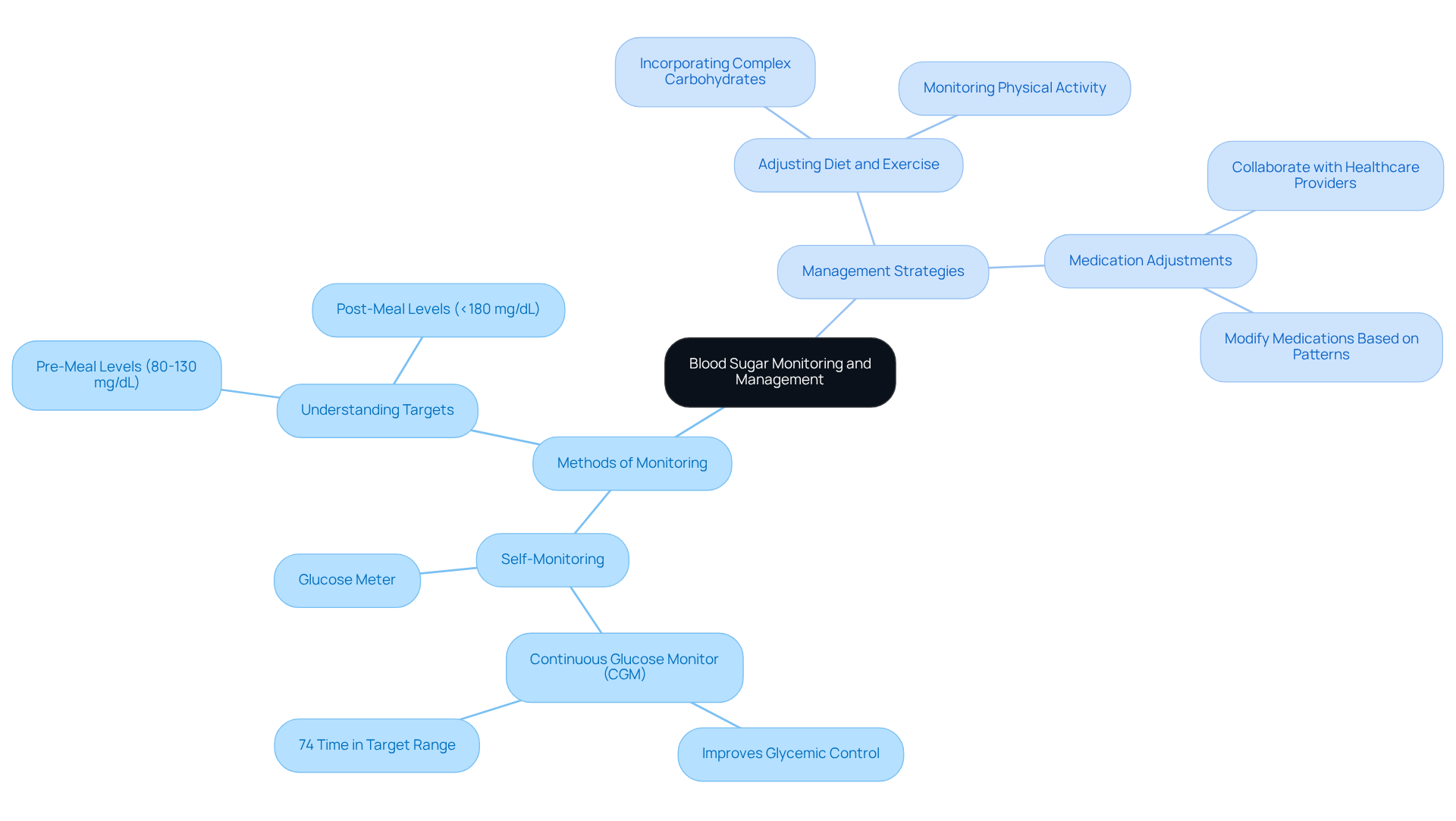
Engage with Community Support and Resources for Diabetes Management
Participating in community assistance can significantly enhance the treatment of diabetes type 2. By joining local or online support groups, you can find emotional backing and practical advice from others who share similar challenges. This fosters a sense of belonging and shared experience. These groups have been shown to improve self-care practices and overall health outcomes, highlighting their effectiveness in the treatment of diabetes type 2 by helping to control blood sugar levels.
Utilizing educational resources from reputable organizations, such as the American Diabetes Association and local health departments, is essential for the treatment of diabetes type 2. These resources offer valuable materials and workshops that equip you with the knowledge needed to manage your condition effectively. Collaborating with healthcare providers, including nutritionists and educators, allows for the development of personalized plans tailored to the treatment of diabetes type 2 and your unique needs.
Moreover, engaging in online communities and social media groups focused on health management promotes ongoing support and information exchange. This network not only fosters resilience but also enhances your overall well-being, empowering you to take charge of your health journey. As T2DSolutions prepares to launch, it will provide a variety of resources and events designed to support individuals with Type 2 diabetes, further enriching the landscape of community support.
Addressing the prevalence of mental health issues is crucial, as 25% of individuals report experiencing comorbid depression or anxiety. This underscores the importance of a supportive community in navigating these challenges. Remember, you're not alone in this journey; we are here to support you every step of the way.
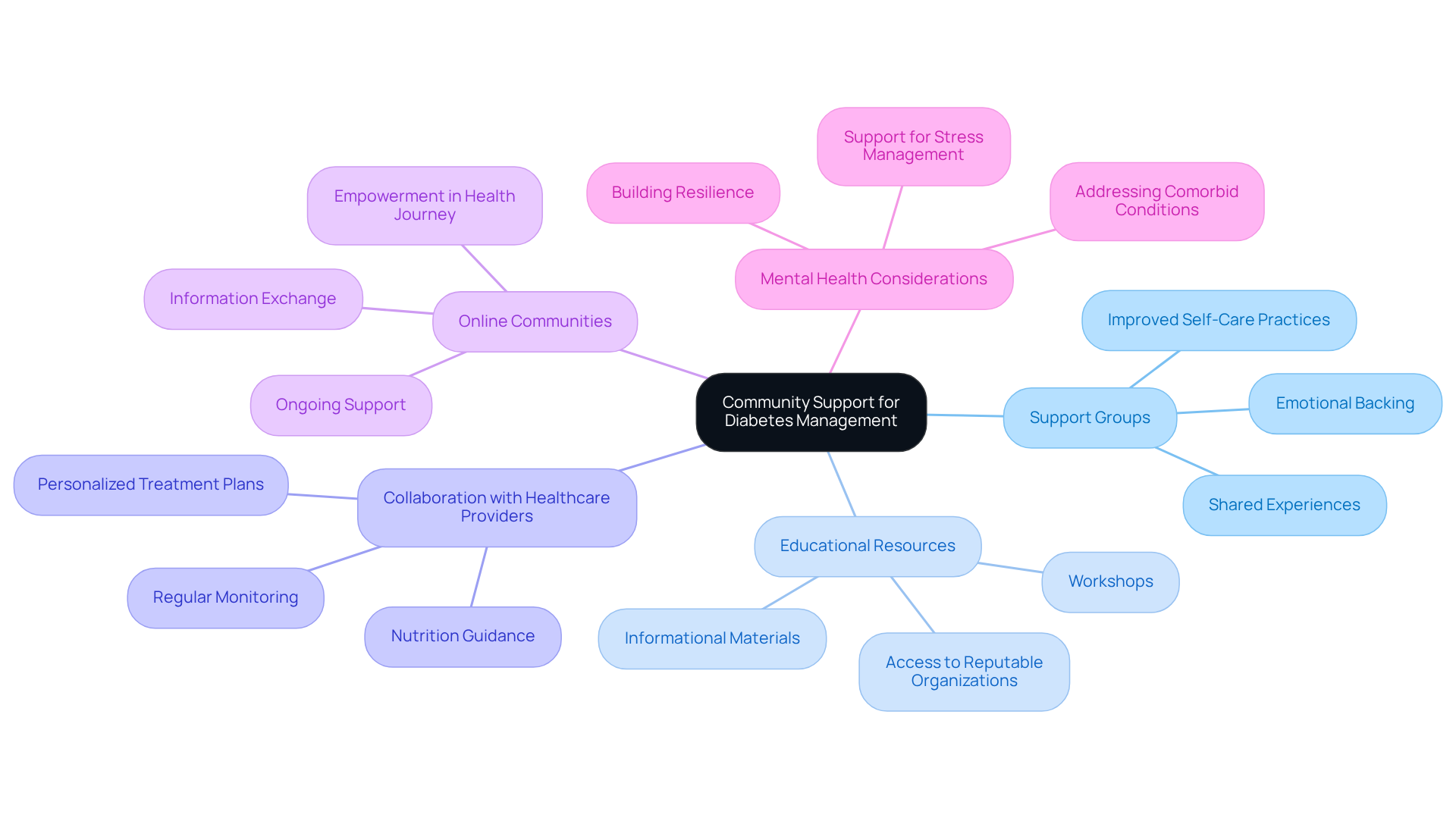
Conclusion
Understanding and managing Type 2 Diabetes can feel overwhelming, but it’s a journey that many are on together. This article highlights the vital importance of recognizing the condition, addressing insulin resistance, and making effective lifestyle changes. By focusing on education, community support, and proactive health strategies, you can significantly improve your health outcomes and overall quality of life.
Key insights emphasize the importance of lifestyle modifications such as:
- A balanced diet
- Regular exercise
- Weight management
These are essential for controlling blood sugar levels. Additionally, monitoring your blood sugar and collaborating with healthcare providers to tailor treatment plans is crucial. Engaging with community resources and support groups can further enhance your management journey, offering emotional backing and practical advice.
Ultimately, fighting against Type 2 Diabetes is not just about individual efforts; it calls for a collective commitment to health and well-being. By leveraging available resources, embracing lifestyle changes, and fostering community connections, you can take charge of your health. This proactive approach not only aids in managing diabetes but also contributes to a healthier future for everyone. Remember, you're not alone in this journey; we are here to support you every step of the way.
Frequently Asked Questions
What is Type 2 Diabetes?
Type 2 Diabetes is a long-term condition characterized by insulin resistance, where the body does not use insulin efficiently, leading to increased blood glucose levels. Unlike Type 1 Diabetes, individuals with Type 2 may still produce insulin but struggle to utilize it effectively.
How prevalent is Type 2 Diabetes in the United States?
Approximately 38.4 million Americans, or 11.6% of the population, are affected by Type 2 Diabetes, which accounts for 90-95% of all diabetes cases.
What are the main risk factors for developing Type 2 Diabetes?
Key risk factors include obesity, physical inactivity, age (especially over 45), family history of diabetes, and certain ethnic backgrounds, including African Americans, Hispanic Americans, and Native Americans.
How does obesity relate to Type 2 Diabetes?
Excess body fat, particularly around the abdomen, significantly increases insulin resistance. About 89.8% of adults with high blood sugar are classified as overweight or obese, highlighting the strong link between obesity and Type 2 Diabetes risk.
What role does physical activity play in managing Type 2 Diabetes?
A sedentary lifestyle contributes to weight gain and worsens insulin resistance. Many adults with Type 2 Diabetes engage in minimal physical activity, indicating a barrier to effective management that can be addressed through increased exercise.
Can Type 2 Diabetes be managed or reversed?
Yes, lifestyle modifications such as diet and exercise can significantly improve insulin sensitivity. Weight reduction and increased physical activity can help control and potentially reverse insulin resistance.
What are the financial implications of Type 2 Diabetes in the U.S.?
In 2017, Type 2 Diabetes incurred $327 billion in expenses in the U.S., which included $237 billion in healthcare costs and $90 billion in lost productivity.
How does T2DSolutions support individuals with Type 2 Diabetes?
T2DSolutions provides comprehensive diabetes education, resources for dietary and exercise plans, and fosters a supportive community for individuals to share experiences and navigate their care journey effectively.
What is the emerging idea related to sugar metabolism disorders and Alzheimer's disease?
T2DSolutions addresses a potential third form of sugar metabolism disorder that may be associated with Alzheimer's disease, providing insights for those affected by both conditions.
Why is understanding the causes and risk factors of Type 2 Diabetes important?
Understanding these factors enables individuals to adopt proactive health care approaches, such as maintaining a healthy weight and engaging in regular physical activity, which can significantly reduce the risk of developing Type 2 Diabetes.



